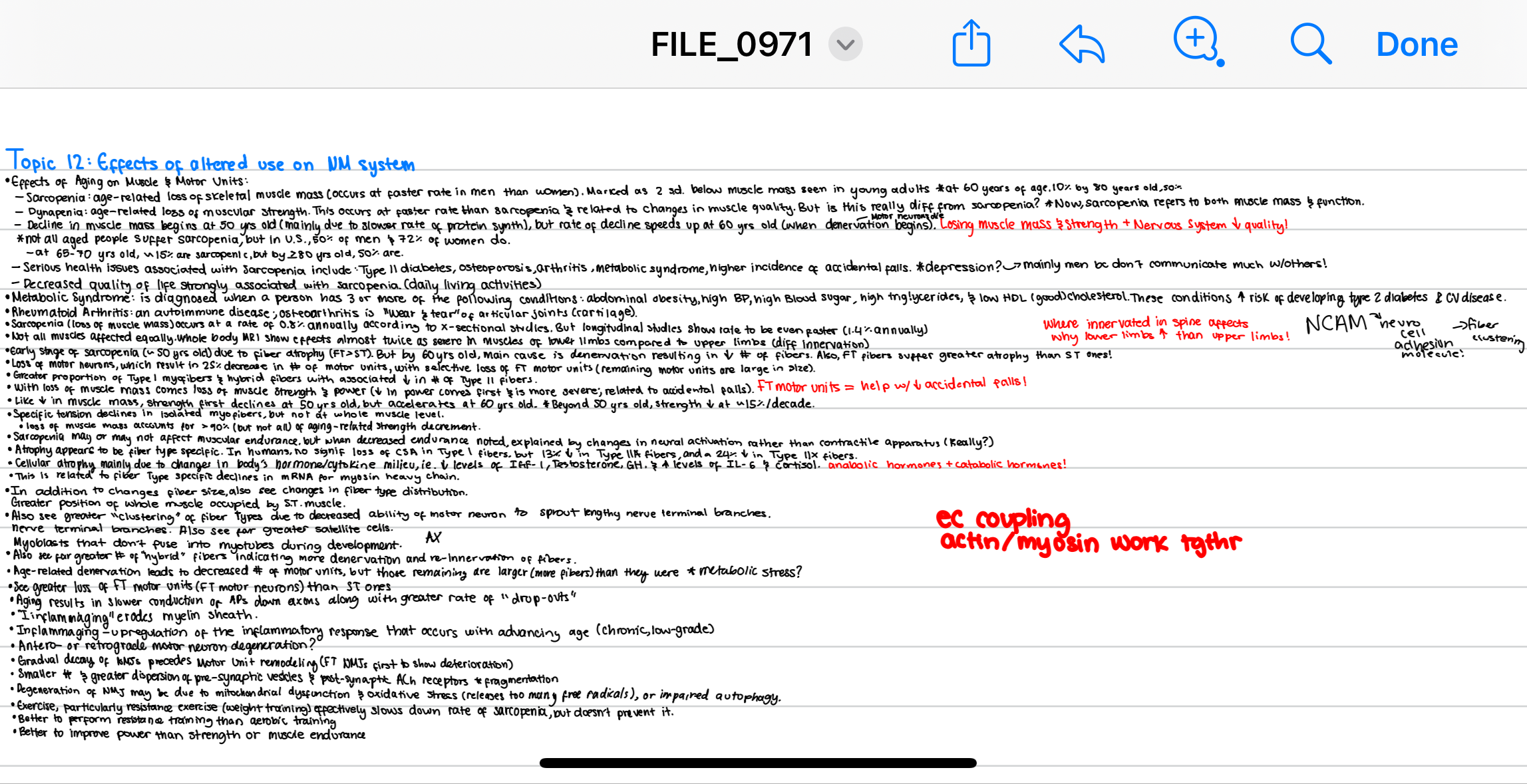topic 12
Effects of Altered Use on NM System

🔹 Effects of Aging on Muscle & Motor Units:
Sarcopenia= Age-related loss of skeletal muscle mass (occurs at earlier rate in men than women).
Marked as 2 standard deviations below muscle mass seen in young adults *at age 60 years 10% muscle mass loss By 80: 50% muscle mass loss
Dynapenia = age-related loss of muscular strength.
This occurs at a faster rate than sarcopenia & related to changes in muscle quality
Is this really different from sarcopenia? *now, Sarcopenia refers to both (mass + function).
Decline in muscle mass begins at 50 years old (mainly due to slower rate of protein synth), but rate of decline speeds up at 60 years old (when denervation[motor neurons die] begins. **losing muscle mass & strength + nervous system decreases quality!
Not all aged people suffer sarcopenia, but in US, 50% of men & 72% of women do
At 65-70 yrs old, ~15% are sarcopenic, but by >80 yrs old, 50% are
Serious health issues associated with sarcopenia include: type II diabetes, osteoporosis, arthritis, metabolic syndrome, higher incidence of accidental falls. *depression? → mainly men bc don’t communicate with others
Decreased quality of life strongly associated with sarcopenia (daily living activities)
Metabolic Syndrome: diagnosed when person has 3+ of the following:
abdominal obesity, high BP, high blood sugar, high triglycerides, low HDL (good) cholesterol
→these conditions ↑ risk of developing type 2 diabetes & cardiovascular disease
Rheumatoid Arthritis: an autoimmune disease where the body's immune system mistakenly attacks the lining of joints
osteoarthritis = "wear & tear" of articular joints (cartilage)
→ sarcopenia (loss of muscle mass) occurs at 0.8% annually according to cross-sectional studies. But longitudinal studies show rate to be even faster (1.4% annually)
→ Not all muscles affected equally → whole body MRI shows effects almost twice as severe in muscles of lower limbs (postural muscles) > upper limbs (different innervation)
→Early signs of sarcopenia (~50 yrs old) due to fiber atrophy (FT>ST) But by 60 yrs old, main cause is denervation resulting in decrease # of fibers. Also, FT fibers suffer greater atrophy than ST ones!
→Loss of motor neurons, which results in 25% decrease in # of motor units, with selective loss of FT motor units (remaining motor units are larger in size)
Greater proportion of Type I myofibers & hybrid fibers associated with ↓ in # of Type II fibers.
→ With loss of muscle mass comes loss of muscle strength & power (↓ in power comes first & is more severe; related to accidental falls) FT motor units = help w/ accidental falls
→ like ↓ in muscle mass, strength first declines at 50 yrs old, but accelerates at 60 yrs old. *Beyond 50 yrs old, strength ↓ at ~15%/decade.
Specific tension declines in isolated myofibers, but not at whole muscle level.
→ loss of muscle mass accounts for >90% (but not all) of aging-related strength decrement
→ Sarcopenia may or may not affect muscular endurance, but when decreased endurance noted, explained by changes in neural activation rather than contractile apparatus (really?)
→ Atrophy appears to be fiber type specific. In humans, no significant loss of CSA in type I fibers but 13% ↓ in Type IIa fibers, and a 24% ↓ in Type IIx fibers.
→ Cellular atrophy mainly due to change in body’s hormone/ cytokine milieu, i.e. ↓ levels of IGF-1, testosterone, GH and ↑ levels of IL-6 & cortisol. anabolic hormones + catabolic hormones!
This is related to fiber type specific declines in mRNA for myosin heavy chain.
→ In addition to changes in fiber size, also see changes in fiber type distribution. Greater portion of whole muscle occupied by ST motor units.
→ Also see greater “clustering” of fiber type due to decreased ability of motor neuron to sprout lengthy nerve terminal branches.
→ Also see far greater satellite cells (myoblasts that don’t fuse into myotubes during development.
→ also see far greater # of “hybrid” fibers indicating more denervation and re-innervation of fibers
→ Age-related denervation leads to decreased # of motor units, but those remaining larger (more fibers) than they were *metabolic stress?!
→ See greater loss of FT motor units (FT motor neurons) than ST ones.
→ Aging results in slower conduction of APs down axons along with greater rate of “drop-outs”
→”inflammaging” erodes myelin sheath
Inflammaging - up-regulation of the inflammatory response that occurs with advancing age (chronic/low-grade)
→ Antero or retrograde model motor neuron degeneration?
Anterograde degeneration, also known as "dying-forward," starts in the motor cortex and travels down to the spinal cord. Retrograde degeneration, or "dying-back," begins at the neuromuscular junction and spinal cord and travels back towards the motor cortex
→ gradual decay of fibers precedes motor unit remodeling (FT NMJ first to show deterioration)
→ Smaller # & greater dispersion of pre-synaptic vesicles & post-synaptic ACh receptors *fragmentation
→ Degeneration of NMJ may be due to mitochondrial dysfunction & oxidative stress (releases too many free radicals), or impaired autophagy.
→ Exercise, particularly resistance exercise (weight training) effectively slows down rate of Sarcopenia, but doesn’t prevent it.
→ better to perform resistance training than aerobic training
→ Better to improve power more than strength or muscle endurance